MARLIN DIY
PART 3
In the last two issues, we covered rigging, boat set-up and lure selection for targeting striped marlin on lures. Now it’s time to hit the water!
Words & Images by Ben Brown
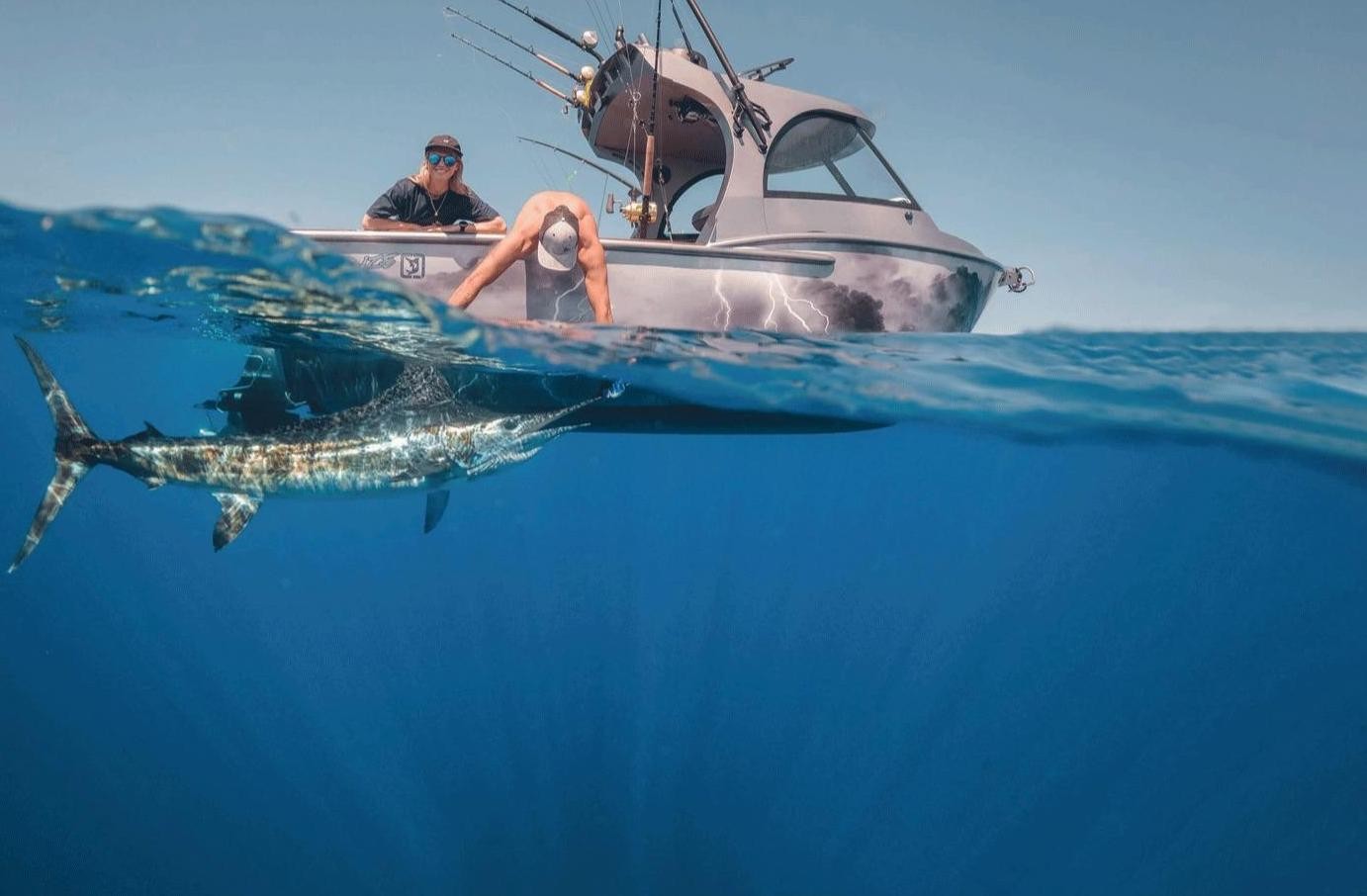
Finding fish
There are several tools I call upon when I’m trying to find fish – there’s no magic bullet to finding marlin unfortunately, but there are a few things you can look for to tip the odds in your favour. First and foremost, the best way to find fish is to get up-to-date intel – share information with your mates, chat with the guys at the local fishing club or troll Facebook groups for information (Facebook chat pages can be valuable resources when looking for fresh intel). In my opinion, there is nothing more crucial to finding fish than knowing where they were the day before as chances are they won’t have gone far.
This isn’t always an option however as weather may have prevented anyone from fishing in the days prior and fishers aren’t always keen to share information. Sea surface temperature (SST) and current charts can be valuable resources when determining where to head in search of these often-elusive fish. Up-todate SST charts can help you identify temperature breaks that will often hold baitfish, and they are extremely useful when looking for different currents and eddies – all factors that may signal where you are likely to find bait, and ultimately marlin.
I will also consult my SST charts retrospectively after I have caught a fish, to see if I can identify any environmental factors that may have led to a fish being in that location. Over time a pattern can often emerge, and I can apply that knowledge gained to my future prospecting. The world of SST charts is complicated and will take some time to figure out – there are a couple of New Zealand-based forecasters who provide customised SST charts along with the resources around how to read them and identify where fish may be. They are well worth looking into.
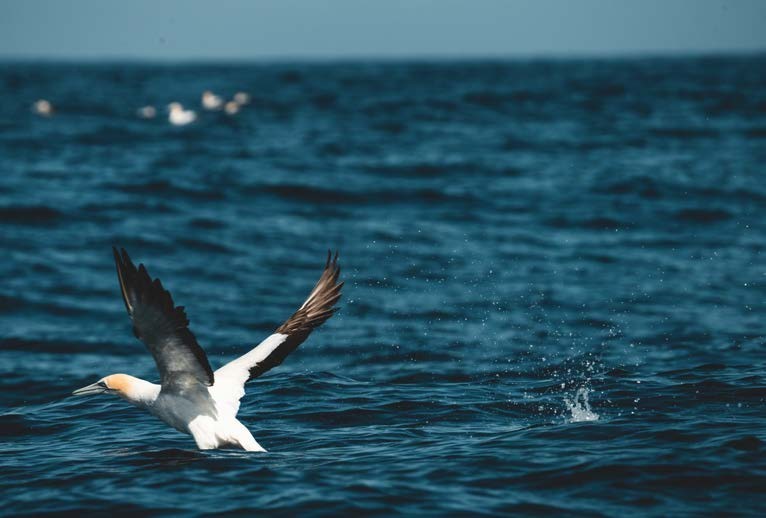
Gannets are always a welcome sight when hunting marlin.

Binoculars are a great tool for finding anything that might indicate the presence of bait and marlin, like surface disturbances, current lines, feeding baitfish, birds, and changes in water colour.
A good sonar set-up can also be extremely useful when trying to find marlin. Whilst on the odd occasion we do mark individual marlin, what I am generally looking for is bait – particularly tight bait balls within 50m of the surface. I’ll also keep an eye on my water temperature graph but I am not looking for warm water, I am far more interested in significant temperature fluctuations – only because these temperature breaks can cause baitfish to hold up. I often hear people on the radio getting excited about very warm water temps throughout the day – the only problem is it isn’t much use to you if there’s no bait in it, as unfortunately marlin don’t eat warm water!
Lastly, don’t forget to use your eyes – look for anything that might indicate the presence of bait and marlin. Surface disturbances, current lines, feeding baitfish, birds, changes in water colour… anything that piques your interest. It’s a big wide ocean out there, try to look for reasons where they might be hiding. Always remember though – once you have found a fish the hard work is done. If I see a feeding marlin or raise one in the gear, I am staying in that spot for the rest of the day. Just like humans, marlin don’t eat all day – the trick is to be in the right spot when they do. Bite times are a real thing, just listen to your VHF the next time you are trolling – chances are there will be a wave of hookups at a certain time of the day.

Up-to-date SST charts can help you identify temperature breaks that will often hold baitfish like this school of saury.
Fighting fish
So, you’ve got all your gear ready, chosen a deadly spread of lures and you’re in a hot patch of water – now for the fun part! If you have added surface teasers to your spread, the first thing you want to do when you see a fish in your gear is pull them in as quickly as possible, even if the fish popped up on the teaser. Marlin can get pretty fixated on surface teasers but they’ve done their job – we now want them fixated on a lure. The dredge isn’t quite as important but it’s a good idea to get it out of the water and secured on the end of your dredge boom as quickly as you can (you don’t want to drive over it, trust me!).
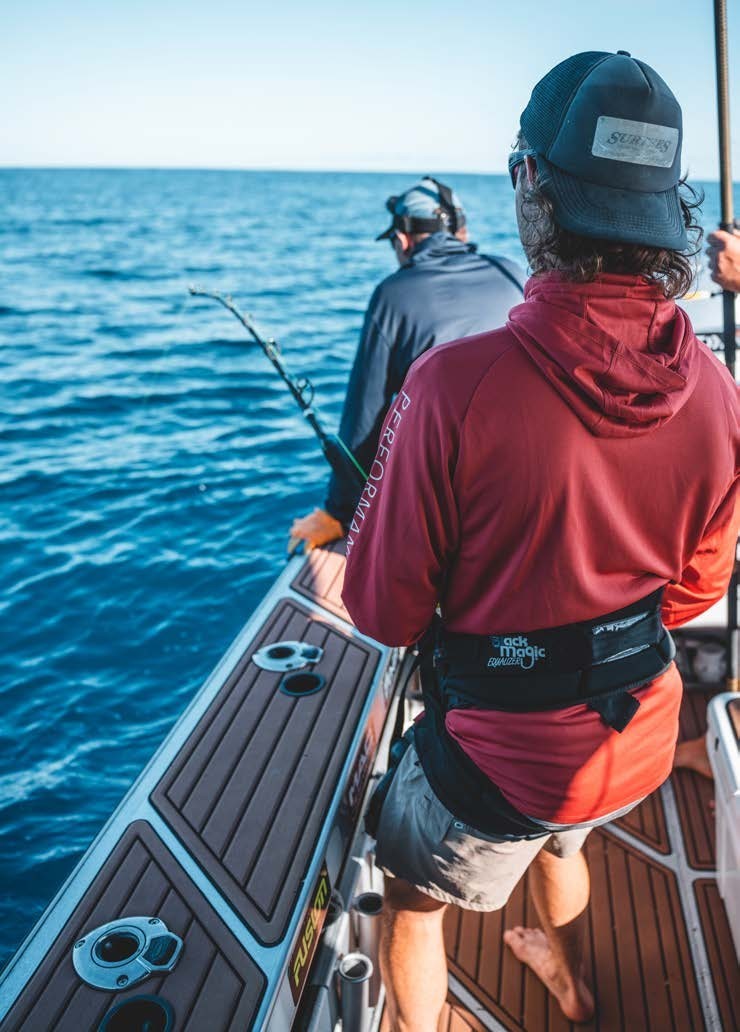
Ben always tries to stay behind the fish during the fight, whether he is going forward or in reverse.
The first thing I’ll do as soon as we get a bite is back the drag off a little – at this point the fish is either hooked or not hooked and my biggest concern is staying attached. I’ll then slow the boat down and get the gear cleared as quickly as possible with the intention of getting the angler on the starboard side of the cockpit as soon as I can. After the gear is cleared, I’ll raise my starboard outrigger out of the angler’s way, and turn the boat to run down the length of the line, effectively staying behind the fish. The reason I am doing this is that I want the drag of the line and lure running behind and away from the fish’s mouth, so that even if the fish isn’t properly hooked the hooks will get pulled into the fish’s mouth, or down its bill, as opposed to out of its mouth.
At this stage of the fight, we are only using as much drag as is required to get the line back on the spool, which is often very little, as the boat is doing most of the work. Now every fight is different of course, but there are rules that we always try to follow during a fight. We will always try and stay behind the fish, whether we are going forward or in reverse. If the fish is jumping or thrashing on the surface, we will back the drag off to almost freespool to prevent pulling the lure out of its mouth. If during the fight the fish digs down deep, we will use drag control to change its mind – if you increase the drag when the fish is digging down you will often notice a very obvious change in the fish’s behaviour and it will come to the surface. When it does this, we will back off the drag again to a position where we are using only as much as required to gain line back. I find it really fun using the boat to chase the fish – it’s easier on the angler and better for the fish as it can often result in very quick captures.
As I have already said, every fish (and every fight) is different and with time you will figure out how you want to fight them – it’s definitely a learning process but man, what a fun process it is!
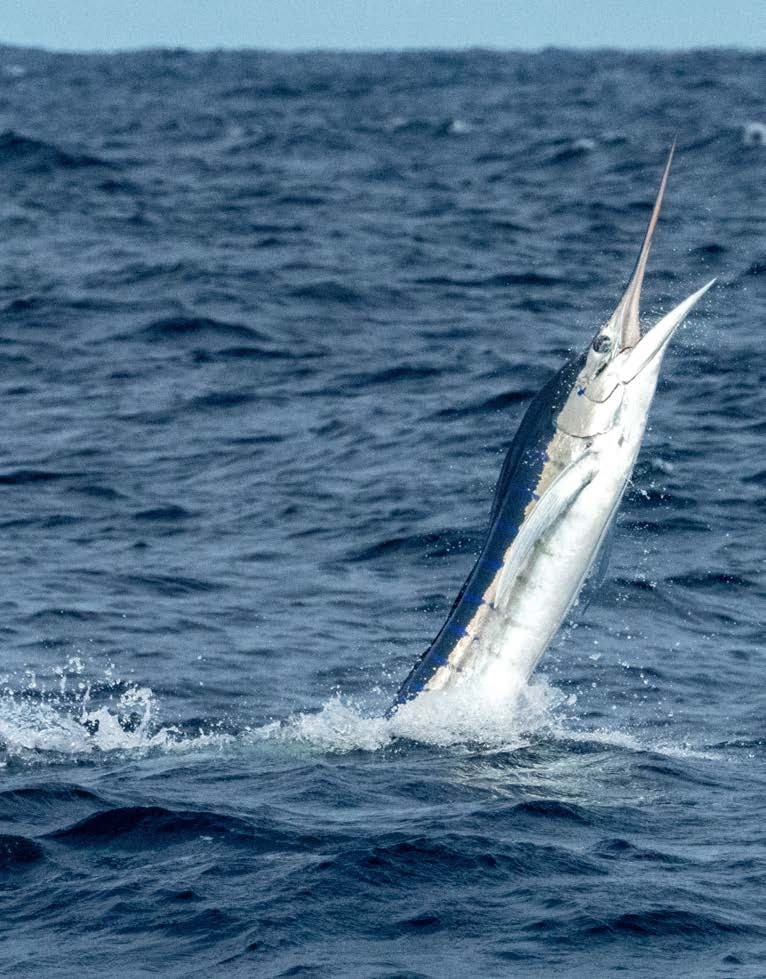
Catching marlin is definitely a learning process but it’s a fun one!

If Ben sees a feeding marlin or raises one in the gear, he stays in that spot for the rest of the day.
“ MOMENTS OF INTENSE EXCITEMENT, SUCCESS, HEARTBREAK, TEAMWORK… ALL FACTORS THAT MAKE IT EXTREMELY ADDICTIVE. ”
Final words
Marlin fishing can be one of the most rewarding forms of fishing. It ticks all the boxes for me – moments of intense excitement, success, heartbreak, teamwork… all factors that make it extremely addictive and keep me coming back year after year. There is definitely a steep learning curve when you are starting out, and investing in gaining knowledge from someone who is willing to share it can shorten that learning curve significantly. Everything that I have mentioned in this article was learnt from the foundations that Bonze laid when he shared his knowledge with me, and he continues to share his experience on boat set-up and technique (he also makes great lures!).
We are very lucky to have an incredible marlin fishery in New Zealand but it wasn’t always so. In the 1980s the fishery was in a rapid decline due to commercial longline pressure. A threeyear billfish moratorium was introduced in October 1987 in response to concerns over the decline in the availability of striped marlin to recreational fishers. The moratorium prohibited the retention of marlin species (striped, blue and black marlin) by commercial fishermen in the entire EEZ of New Zealand. In return, it was expected that anglers would tag and release at least 50% of the marlin catch. In 1991 the moratorium was changed into a regulation and the improvement in the fishery was immense – the average catch from 1975 to 1985 was 505 striped marlin per year, between 1995 and 2005 it was 1,660. The decision as to whether you tag and release or harvest a marlin is yours, but it’s worth remembering those stats if you can’t decide whether to reach for the gaff or the tag pole.
Let’s hope the 2024 season is another cracker for Kiwi fishos. Tight lines team – we’ll see you out there.
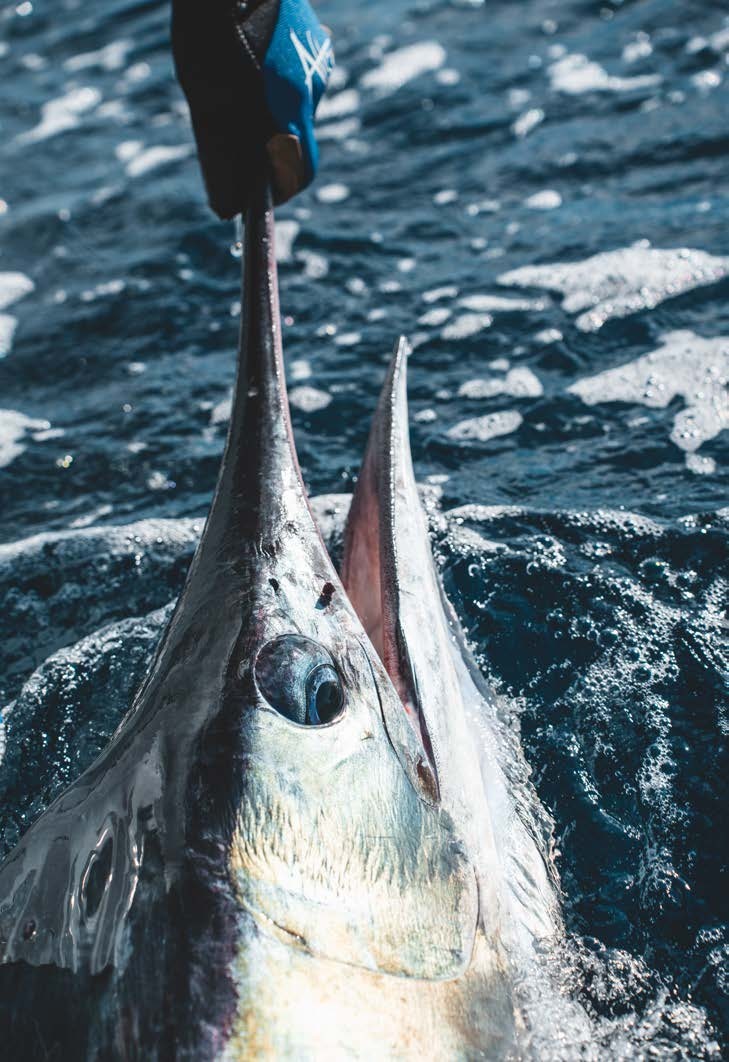
We are very lucky to have an incredible marlin fishery in New Zealand but it wasn’t always so.
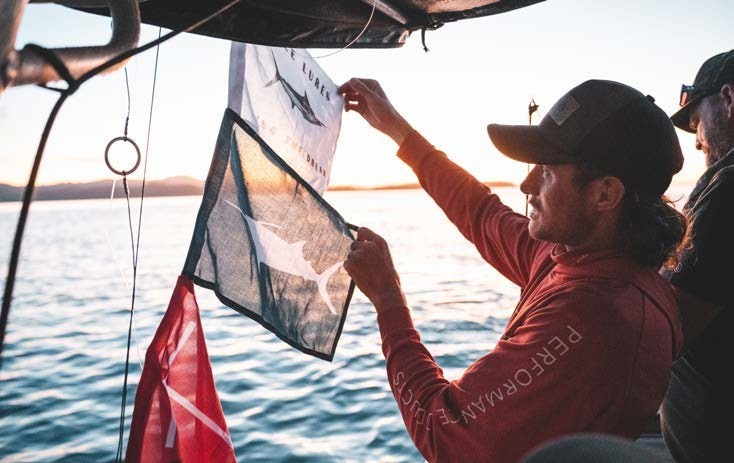
Success!